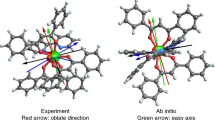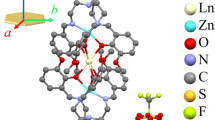Abstract
NYHOLM1 has pointed out that in the d9 configuration Fe−I, Co0, NiI, CuII, the presence of metal–metal interaction with the formation of binuclear complexes is common. In marked contrast to the other ions of this series, however, many compounds of copper II are known where no such interaction appears to occur. The variation found for the copper complexes has been correlated with the ligand polarizability, and it has been suggested from consideration of the isoelectronic ions that such interaction occurs more readily with the more polarizable ligand groups, so reducing the effective charge on the copper ions and allowing favourable overlap of the appropriate metal orbitals1–3. Martin et al.3,4 have investigated a series of alkyl carboxylic acid complexes of copper II by magnetic and cryoscopic methods and shown that the dimeric copper acetate structure in which four acetate groups bridge the two copper ions and there is a direct interaction between the copper ions, with the formation of a δ-bond, appears to apply to this series with the exception of the formate complexes. The difference in the magnetic properties of the acetate and the formate compounds has been attributed to a difference in the structure of the compounds which has been related to the lower polarizability of the formate group3. Thus a carboxylic acid may bond to metal ions to form polynuclear complexes in one of three ways3:  The interaction between the metal ions will be greatest in structure (a). If the repulsion between the metal ions is significant this will increase as the effective positive charge on the metal increases. Any bonding between orbitals of the two ions M will also tend to decrease as the charge on the metal increases., as the orbitals will be contracted by any increase in effective nuclear charge reducing the overlap. Thus structures (b) and (c) will be favoured by the decrease in the polarizability of the acid. In agreement with this copper acetate has a structure corresponding to (a) whereas the copper formate tetra-hydrate (ref. 5) has a structure (b) and one form of anhydrous copper formate6 a structure of type (c).
The interaction between the metal ions will be greatest in structure (a). If the repulsion between the metal ions is significant this will increase as the effective positive charge on the metal increases. Any bonding between orbitals of the two ions M will also tend to decrease as the charge on the metal increases., as the orbitals will be contracted by any increase in effective nuclear charge reducing the overlap. Thus structures (b) and (c) will be favoured by the decrease in the polarizability of the acid. In agreement with this copper acetate has a structure corresponding to (a) whereas the copper formate tetra-hydrate (ref. 5) has a structure (b) and one form of anhydrous copper formate6 a structure of type (c).
This is a preview of subscription content, access via your institution
Access options
Subscribe to this journal
Receive 51 print issues and online access
$199.00 per year
only $3.90 per issue
Buy this article
- Purchase on Springer Link
- Instant access to full article PDF
Prices may be subject to local taxes which are calculated during checkout
Similar content being viewed by others
References
Nyholm, R. S., Proc. Chem. Soc., 273 (1961).
Coffey, E., Lewis, J., and Nyholm, R. S., J. Chem. Soc. (in the press).
Martin, R. L., and Waterman, H., J. Chem. Soc., 1359 (1959).
Figgis, B. N., and Martin, R. L., J. Chem. Soc., 3837 (1956). Martin, R. L., and Waterman, H., J. Chem. Soc., 2545 (1957). Martin, R. L., and Whitley, A., J. Chem. Soc., 1394 (1958).
Kiriyama, R., Ibamoto, H., and Matsuo, K., Acta Cryst., 7, 482 (1954)
Barclay, G. A., and Kennard, C. H. L., J. Chem. Soc., 3289 (1961).
Ploquin, J., and Vergneau-Souvray, C., Bull. Soc. Chim., 18, 757 (1951).
Tsuchida, R., and Yamada, S., Nature, 176, 1171 (1955).
Author information
Authors and Affiliations
Rights and permissions
About this article
Cite this article
LEWIS, J., THOMPSON, R. Magnetic Properties of some Aryl-Carboxylates of Copper II. Nature 200, 468–469 (1963). https://doi.org/10.1038/200468a0
Issue Date:
DOI: https://doi.org/10.1038/200468a0
This article is cited by
-
Preparation and properties of yttrium, lanthanum, and lanthanidem-nitrobenzoates
Monatshefte für Chemie - Chemical Monthly (1988)
-
Electron paramagnetic resonance and the structure of Cu(II) benzoates
Theoretical and Experimental Chemistry (1971)
-
Magnetic susceptibility of copper (II) dicarboxylates
Journal of Structural Chemistry (1969)
Comments
By submitting a comment you agree to abide by our Terms and Community Guidelines. If you find something abusive or that does not comply with our terms or guidelines please flag it as inappropriate.



